简单句的五种基本句型及句子成分
英语简单句(句子成分+5大基本句型+句子结构)

• 6.Many teachers live in another city. 主+谓
1. He likes eggs, but he doesn’t like chickens. 并列句 2. Work hard or you will fall behind. 并列句
4. ---__________ weather it is! We can’t go boating on the Xuanwu Lake.
---Don’t worry. Let’s go to the Science Museum instead. A. What a bad B. How bad C. What bad
选择疑问句中一般用or连接,回答时不能使用 yes或no,而要用一个完整的句子或省略形式。
① —Do you like apples or pears? ② —Which would you like better, tea or coffee?
首页
目录
尾页
直击中考考点
◆反意疑问句
1. 反意疑问句的常见用法 (1) 反意疑问句遵循“前肯后否,前否后肯”的原则。
意为“某人也一样”, 是表示肯定的倒装。 Ou Baizi passed this English exam, so did I .
欧百子通过了这次英语考试,我也通过了。 2. 易混句式:so+主语+助动词/系动词/情态动词。
意为“确实是……”。
—Ouyang Xue dances very well.欧阳雪舞跳得很好。
简单句的五种基本句型

简单句的五种基本句型1、主语+谓语(不及物动词)2、主语+谓语(及物动词)+宾语3、主语+系动词+表语4、主语+谓语+间宾(表示人)+直宾(表示物)5、主语+谓语+宾语+宾语补足语▲主语、动词(不及物动词、及物动词、系动词)、宾语及宾语补足语可以称为基本句子成分。
完整的句子一般至少包含2个基本成分,至多4个基本成分。
主语:名词、代词、The + adj、V-ing、动词不定式、从句宾语:名词、代词、The + adj、V-ing、动词不定式、从句宾补:名词、形容词、副词、V-ing、V-ed、从句等联系动词:be / feel/ taste / smell / look(感官动词)/appear /seem/(好像)become /get / grow / turn/go (变化)remain/ keep/stay(保持)等表语:名词、代词、形容词、副词、V-ing、V-ed、动词不定式、从句等主语+谓语(不及物动词)总结:这种句型常与副词、介词短语、不定式、分词等状语一起连用主语+谓语(及物动词)+宾语总结:作宾语的可以是名词、代词、不定式、-ing分词、-ed分词等接不定式作宾语的常见动词有:attempt, dare, decide, desire, expect, hope, intend, learn, need, offer, pretend, promise, refuse, want, wish接-ing分词作宾语的常见动词有:admit, advice, avoid, consider, defend, enjoy, finish, forbid, mind, miss, practise, risk, suggest, give up, can’t help主语+谓语+间宾(表示人)+直宾(表示物)总结:to:give, hand, leave, lend, offer, pass, sell, send, show, teach, tellfor:buy, choose. get, leave, make, save, sing主语+谓语+宾语+宾语补足语总结:作宾语补足语的有名词、形容词、介词短语、不定式、-ing分词、-ed分词等Eg:allow, advise, ask, beg, cause, choose, encourage, force, expect, get, hate, invite, order, warn, teach, tell, want + sb. to do sth.Eg:feel, have, hear, let, make, notice, watch, see + sb. do sth.。
简单句的五种基本结构

简单句的五种基本结构简单句的五种基本结构简单句是由一个主语(或并列主语)和一个谓语(或并列谓语)构成的句子。
简单句的谓语部分包括谓语动词及宾语、宾语补足语、表语等不同句子成分,不同谓语动词的不同组合形成简单句的基本句型。
一、主语+连系动词+表语1. 这一句型中的连系动词除be之外,主要有一下几类:(1) 感官系动词:feel(感到,摸起来), look(看起来), taste(尝起来), sound(听起来), smell(闻起来)①这衣服是丝绸织的,摸上去很柔软。
②这花闻起来很香。
(2) 渐变类系动词:become(变得,成为), come(成为,变为), fall(变得), get(变得), go(变为;成为), grow(变得), turn (变得)①我弟弟已经成为一个著名作家。
②他的梦想变成了现实。
③听到这个消息,那女孩的脸变红了。
(3) 保持类系动词:keep(保持), remain(依然), stay(保持)①请保持安静。
②你能告诉我保持年轻的秘诀吗?③冬天这座山依然是绿的。
④他一直在这个学校当了二十年的老师。
2. 表语可以由名词、代词、形容词、部分副词、数词、介词等来充当。
如:①他是个化学家。
②这些铅笔是我的。
③他的讲话既长又令人厌烦。
④孩子们出去了。
二、主语+不及物动词1. 本句型的不及物动词是表意动词,在句中作谓语,说明主语的行动、状态或心理活动。
有时态变化,人称和数要和主语保持一致。
常见的不及物动词有agree, arrive, burn, come, dance, die, fall, fly, go, hurry, jump, leave(离开), listen, live, look, move, play, rest, ring, rise, run, shout, sit, skate, smile, snow, speak, stand, stay, stop, swim, travel, talk, try, wait, walk, work, worry等(1) 月亮升起来了。
句子成分及简单句的五种形式

句子成分及简单句的五种形式简单句的五种形式:1.主语+谓语(vi)2.主语+谓语+宾语(vt)3.主语+系动词+表语系动词:(1) be(2) become get grow turn come go fall(3) look smell taste sound feel(4) remain hold keep stand stay(5) turn out prove(6) seem appear4.主语+谓语+宾语+宾语补足语(复合宾语)elect,feel,find get, have, hear, imagine, keep, make, notice, see, let, smell, start ,watch, appoint, believe, call, catch ,allow, ask, cause, consider, expect, know,tell, think, want, wish, listen to, look at5.主语+谓语+双宾语(间接宾语+直接宾语)give, bring, tell, send, leave, pass, read, write, take, wish, show ,teach ,get ,award, lend, rent, buy ,pay, hand, recommend句子成分1 主语( 动作的发出者,是一个句子的主体,必须用主格形式I you he she we they)He is a boy. The book is interesting.To find a good friend is difficult.Smoking is bad for your health.What is more important is how to get there.2 宾语(动作的承受着,放在及物动词的后边,必须用宾格形式me you him her us them)We often do homework at 6.I teach him English.I don’t know how to do it.We all believe he is honest.3 谓语(既是动词,表示具体的动作,分为及物动词和不及物动词)Later land animals appeared.The scene looks real.We can’t put up with the pollution.4 主语补足语既主补,用来补充说明主语,可以由名词形容词现在分词过去分词动词不定式介词副词等充当。
句子成分和简单句的五种基本句型(共59张PPT)

系动词(必背)
be
(am is are was were) / seem / keep /…是/好象(似乎)是/保持 / feel / taste / smell / sound / …看/感觉/尝/闻/听起来(上去) 感官 动词 / turn / get / grow / …变得
look
become
基本句型1 S +V (主+谓) 此句型的句子有一个共同特 点,即句子的谓语动词都能表达 完整的意思。 这类动词叫做不及物动词, 后面可以跟副词、介词短语、状 语从句等。
S
1. Time 2. The moon 3. The man 4. We all 5. Everbody 6. I 7. They 8. He
2) SVP 主语+谓语+表语
eg. The plan sounds perfect. Frank is an artist.3) SVO 主语+ Nhomakorabea语+宾语
eg. I saw a bird. My sister enjoyed the play.
简单句的五种句型
4)SVOiOd 主语+谓语+间接宾语+直接宾语
句子成分
组成句子的各个部分叫做句子的成分
它包括主,谓,宾,宾补,表(直宾,
间宾),定,状 主语和谓语是句子的主体部分。 表语,宾语和宾补是谓语里的组成部 分。 定语和状语是句子的次要部分。
句子成分的构成
句子的主干成分:
主语、谓语、宾语、表语
句子的次要成分:
定语、状语、补语、插入语、同位语
主语
1.
及物动词和不及物动词
及物动词是后面可以直接跟宾语的动词:
see / hear / drank / eat / …
句子成分及简单句五种基本句型

句子成分及简单句五种根本句型一、句子成分英语句子成分包括:主语〔Subject=S〕、谓语〔Predicate=P〕、表语〔Predicative〕、宾语〔Object=O〕〔宾语分为间接宾语Indirect Object=IO和直接宾语Direct Object=DO〕、定语〔Attribute〕、状语〔Adverbial Modifier〕、宾语补足语〔Objective complement〕、同位语〔Appositive〕等。
1. 主语主语是谓语讲述的对象,表示所说的“是什么〞或“是谁〞,是句子的中心。
作主语的词有:名词〔n.〕、代词〔pron.〕、不定代词〔idefinite pron.〕、动词不定式〔to do sth〕、动名词〔v-ing〕、或具有名词性质的短语以及主语从句〔Subject clause〕。
主语位于谓语前或句首。
(1) Lucy is a student. (名词作主语)(2) He is my brother. (代词作主语)(3) Something is wrong with my bike.(不定代词作主语)To learn English well is not easy (动词不定式作主语)Smoking is bad for your health.(动名词作主语)What we should do is not yet decided.(主语从句作主语)2. 谓语谓语说明主语“做什么〞或“怎么样〞,是主语的动作或状态。
谓语或谓语局部里主要的词必须是动词。
谓语动词和主语在人称和数上必须要保持一致。
谓语要放在主语后面。
(1) His parents are teachers. (系动词作谓语)(2) We study hard.(行为动词作谓语)(3) don’t study hard.(助动词和行为动词一起作谓语)(4) She can speak English.(情态动词和行为动词一起作谓语)3. 宾语宾语是动作或行为的对象或承受者。
句子成分 简单句的五种基本句型

5. He is in Class One and I am in Class Two. 6. He was fond of drawing when he was yet a child. 7. Neither has he changed his mind, nor will he do so. 8. What he said at the meeting is very important, isn’t it? 9. The farmer is showing the boy how to plant a tree. 10. Both Tom and Jack enjoy country music.
一、判断下列句子是简单句、并列句还是复 合句
1. We often study Chinese history on Friday afternoon. 2. The boy who offered me his seat is called Tom. 3. There is a chair in this room, isn’t there? 4. My brother and I go to school at half past seven in the morning and come back home at seven in the evening.
2 名词(代词)+ 分 词
3 名词(代词)+ 名 词
4 名词 (代词)+ 形容词
1 名词(代词)+ 不定式
John asked me to help him.
Let him go home.
I saw her come out of the room.
名词(代词)+ 分词
简单句的五种基本句型及句子成分

简单句的五种基本句型及句子成分一简单句的五种基本句型(1)主语+系动词+表语主系表结构Frank is clever/an architect.(2) 主语+不及物动词主谓结构My head aches.(3) 主语+及物动词+宾语主谓宾结构My sister enjoyed the play.(4)主语+及物动词+间接宾语+直接宾语主谓宾(双宾语)结构He gave Sam a watch. (5)主语+及物动词+宾语+宾补主谓宾结构They made Sam chairman/monitor.二系动词不及物动词及物动词(1) 系动词:be动词(在进行时或被动语态中除外)一些意思为变得的动词(turn become get go 等)感官动词(feel look smell taste notice sound等)总结:(2)不及物动词:后面不能跟宾语的动词。
总结:(3)及物动词:后面能跟宾语的动词。
注:三句子成分主语:任何句子都表明人或物做了什么动作或处于某种状态,其中的人或物为主语。
宾语:动词或介词后面不可缺少的名词或代词或其他名词性成分。
表语:系动词后面的成分。
定语:修饰名词或代词的成分。
状语:在句子里面表示动作发生的时间,地点,原因,目的,结果,方式,比较,让步,伴随,方式的成分。
补语:补充说明主语或宾语的成分。
(make let have get/ consider find call name/感官动词等) 同位语:解释说明名词或代词的成分。
四练习(1)认识简单句的基本句型。
(是主谓(宾)还是主系表)1.He works hard . 6.The baby is crying.2.To see is to believe. 7.The mouse was eaten by a cat.3.She felt happy at the party. 8.We found the film interesting.4.I teach the second grade. 9.They made me happy.5.He showed me the way to the post. 10.Electricity can make a machine run.(2标明下列句子的成分。
- 1、下载文档前请自行甄别文档内容的完整性,平台不提供额外的编辑、内容补充、找答案等附加服务。
- 2、"仅部分预览"的文档,不可在线预览部分如存在完整性等问题,可反馈申请退款(可完整预览的文档不适用该条件!)。
- 3、如文档侵犯您的权益,请联系客服反馈,我们会尽快为您处理(人工客服工作时间:9:00-18:30)。
简单句的五种基本句型句型一主语+系动词+表语(SLP)[讲解] (1) 系动词的三种分类:在初中阶段,我们学过的表示“保持或状态”类的有be, remain, stay, keep, prove等;表示“变化”类的有grow, turn, get, become, fall, go, come等;表示“感官”类的有look, sound, smell, taste, feel, seem, appea r等。
例如:I am a senior school student while he is a junior one.我是高中生,他是初中生。
After four years, Tom became a doctor/ turned doctor.四年后,汤姆成了一名医生。
The story sounds interesting and instructive.这故事听起来既有趣,又有教育意义。
(2) 可以充当表语的有形容词、名词、副词(短语)、介词短语、表语从句、分词(短语)等。
例如:In order to keep healthy, he takes exercise everyday. (形容词作表语)In my mind, mother is my hero. (名词作表语)Look! Your pet dog is there. (副词作表语)The schoolbags come in different sizes. (介词短语作表语)You’ve changed a lot. You are not what you were. (表语从句作表语)Many passengers got injured in the accident. (过去分词作表语)The machine keeps running for a long time. (现在分词短语作表语)(3) 使用系动词应注意的地方:第一,没有被动语态;第二,一般没有进行时(除了feel以外);第三,有些动词既是系动词又是普通动词。
如:keep, grow, taste, feel, get, smell等。
第四,非谓语一般用现在分词(-ing)(在高中阶段将大量的涉及到。
) 例如:After two-day’s treatment, he felt well again. (不用was felt)He remains an excellent engineer in the factory. (不用is remained)比较以下句子:The pet dog keeps clean. It is kept by Johnson.(keeps是系动词,而kept是及物动词)We grew some trees around our school and they grow green now.(grew是及物动词,而grow是系动词)Just now I felt the table and it felt smooth.(第一个felt是及物动词,而第二个是系动词)[练习] 选择一个合适的词或根据汉语提示填空,注意动词的适当形式。
(1) I __________(remain / keep / stay) a nurse while he has __________(turn / become) engineer.(2) Put the meat in the refrigerator (冰箱). It __________ (go / get / turn / become) bad easily.(3) What he said __________(sound / look / smell / taste) reasonable.(4) He feels __________(comfortable / comfortably) working in the air-conditioned office.(5) We do morning exercises to __________(keep / turn / become) healthy.(6) The apple __________(tastes / is tasted) sweet.(7) Please keep __________(安静); The baby has fallen __________(睡着).(8) They work day and night to make their dream come __________(实现).Key:(1) — (4) remain, turned; goes; sounds; comfortable(5) — (8) keep; tastes; quiet, asleep; tru句型二主语+不及物动词(SV)[讲解] (1)不及物动词不能直接加宾语。
如agree, lie, work, argue, belong, come, go, reply等。
(2) 不及物动词加一个介词后构成动词短语可以加宾语。
如agree with, lie in, work at, belong to, come across, go to等。
(3) 有些动词既是及物动词又是不及物动词。
如begin, sell, write, wash, answer, read等。
例如:The meeting begins at half past nine. (不及物动词)The professor began his speech directly. (及物动词)The books of this kind sell well and he will sell them.(第一个sell为不及物动词,而第二个是及物动词)。
[练习] 1. 指出划线部分动词的词性,是及物动词还是不及物动词。
(1) Speak aloud so that everyone can follow you. ( )(2) Besides Japanese, he can also speak Spanish. ( )(3) His father used to work hard to make much money. ( )(4) I intended to lie to him, but failed. ( )(5) Unfortunately, I failed the driving test. ( )2. 在每一空格上填上恰当的介词。
(1) I don’t agree _____ you completely. I have my own opinion.(2) The dictionary is not Tom’s. It belongs _____ me.(3) Use your head, and you will think _____ some ways to solve the problem.(4) To improve my English, I work hard _____ it.(5) Look _____ the cloudy sky! It is going to rain.Key:1. 不及物动词:(1)、(3)、(4);及物动词:(2)、(5)。
2. (1) — (5) with, to, up, at, at句型三主语+及物动词+宾语(SVO)[练习]划出以下句子的主、谓、宾部分。
如:Doing morning exercises benefits our health.(1) I wrote a passage last night.(2) I doubt whether he will join us in the debate.(3) We missed going to college for that reason.(4) What he said touched me greatly.句型四主语+及物动词+双宾语(间接宾语+直接宾语)(SVOO)[讲解] (1)双宾语指直接宾语与间接宾语。
一般地说,宾语指人为间接宾语,宾语指物为直接宾语。
例如:My father bought me a car.(me为间接宾语,a car 为直接宾语)The singer sang us another song.(us为间接宾语,another song 为直接宾语)(2)如果直接宾语放在及物动词之后、间接宾语之前,那么两个宾语之间应有一个介词(to, for等)。
The teacher offered some advice on learning English to us.The singer sang another song for us.[练习]在每一空格上填上一个恰当的介词。
(1) Mother bought a birthday cake ______me.(2) Give another apple______her. She likes it.(3) The company will provide some drinks ______ the volunteers.Key:句型三(1) I wrote a passage last night.(2) I doubt whether he will join us in the debate.(3) We missed going to college for that reason.(4) What he said touched me greatly.句型四(1) — (3) for; to; for句型五主语+及物动词+复合宾语(宾语+宾补)(SVOC)[讲解] 宾补是用来描述或说明宾语的动作、状态或特征。
宾语是宾补的逻辑主语(暗含的主语)。
宾补可由名词、代词、形容词、副词、介词短语、不定式(短语)、分词(短语)等来充当。
例如:Tom made the baby laugh. (不带to的不定式laugh作宾补)Tell him to follow the instructions. (不定式短语作宾补)They made Beijing the capital of the PRC. (名词作宾补)We saw the old man crossing the street when we walked. (现在分词短语作宾补)I tried my best to make the lesson a lively one. (不定代词one作宾补)What made you here? (副词作宾补)We found ourselves in great trouble. (介词短语作宾补)Don’t leave the machine working all day long. (现在分词短语作宾补)[练习]根据汉语或英语提示在空格上填一个恰当的单词。
